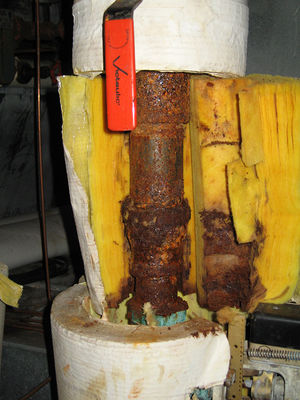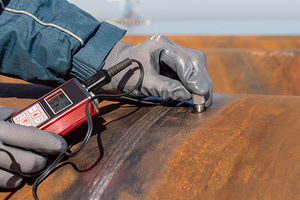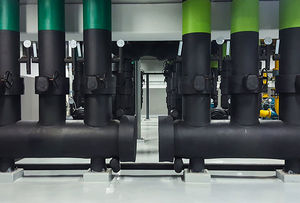 Corrosion under insulation (CUI) is a type of metal corrosion that occurs when moisture becomes trapped between a pipe and the insulation. CUI is a common concern in chilled water or refrigeration systems because the equipment operates below the ambient temperature making condensation a huge source for moisture.
Corrosion under insulation (CUI) is a type of metal corrosion that occurs when moisture becomes trapped between a pipe and the insulation. CUI is a common concern in chilled water or refrigeration systems because the equipment operates below the ambient temperature making condensation a huge source for moisture.
CUI can be very difficult to find and evaluate because it is hidden under insulation. It is often detected only after the damage is done and leaks in pipes or systems occur. Once CUI happens it will reduce the service life of mechanical systems, cause shutdowns and require costly repairs.
What is a CUI inspection?
A CUI inspection is simply a process to check pipes for corrosion, damage, and needed repairs and is a vital part of system maintenance. Logistically some inspection methods are more challenging than others so understanding inspection options is important because there are advantages and disadvantages to each.
How do you inspect corrosion under insulation?
 The four most common ways to check for CUI are visual inspection, radiography, ultrasonic thickness measurement, and pulsed eddy current.
The four most common ways to check for CUI are visual inspection, radiography, ultrasonic thickness measurement, and pulsed eddy current.
- Visual inspection is the simplest method and involves cutting plugs in the insulation or removing sections that can be replaced and then visually examining the surface of a pipe for any signs of damage or corrosion. It is effective but the downside of this method is that it is expensive, and it only allows the outer areas of the piping to be checked and not the internal space.
- Radiography is another common CUI inspection method. This X-ray technology is used in a variety of ways, such as real-time radiography (RTR), computed radiography (CR) and digital detector arrays (DDA). Each method operates on the principle of X-rays providing a view of a pipe’s diameter profile through the insulation and highlighting areas of change or thickness, which can indicate a build-up of corrosion. Advantages include fast analysis, traceability and digital archiving.
- Ultrasonic Thickness Measurement (UT) is an effective, highly accurate and versatile remote visual inspection technique that is widely used in many industries. It works on the principle of the movement of ultrasound waves and can measure wall thickness through a variety of linings and coatings.
- Pulsed Eddy Current (PEC) uses electromagnetic waves to determine the wall thickness of any material that conducts electricity. This method delivers a high degree of accuracy even though the probes don’t require contact with the test surface, but because the technology only provides an average wall thickness it is generally only used as a screening technique and not for detecting isolated areas of corrosion.
 Want to reduce the risk of CUI? When installed properly, Armacell’s insulation solutions are designed to prevent condensation on below-ambient piping and equipment. If there is no moisture ingress and condensation forming next to the pipe you won’t have corrosion issues. Regular inspection and maintenance is advised to make sure seams stay sealed along the entire pipe or unit, and the installation should last the life of the system. This broad overview of CUI inspection methods is only a guide and any decision on the most appropriate technology for a specific application warrants much closer examination and understanding. Contact our dedicated technical team for more information or any questions.
Want to reduce the risk of CUI? When installed properly, Armacell’s insulation solutions are designed to prevent condensation on below-ambient piping and equipment. If there is no moisture ingress and condensation forming next to the pipe you won’t have corrosion issues. Regular inspection and maintenance is advised to make sure seams stay sealed along the entire pipe or unit, and the installation should last the life of the system. This broad overview of CUI inspection methods is only a guide and any decision on the most appropriate technology for a specific application warrants much closer examination and understanding. Contact our dedicated technical team for more information or any questions.
